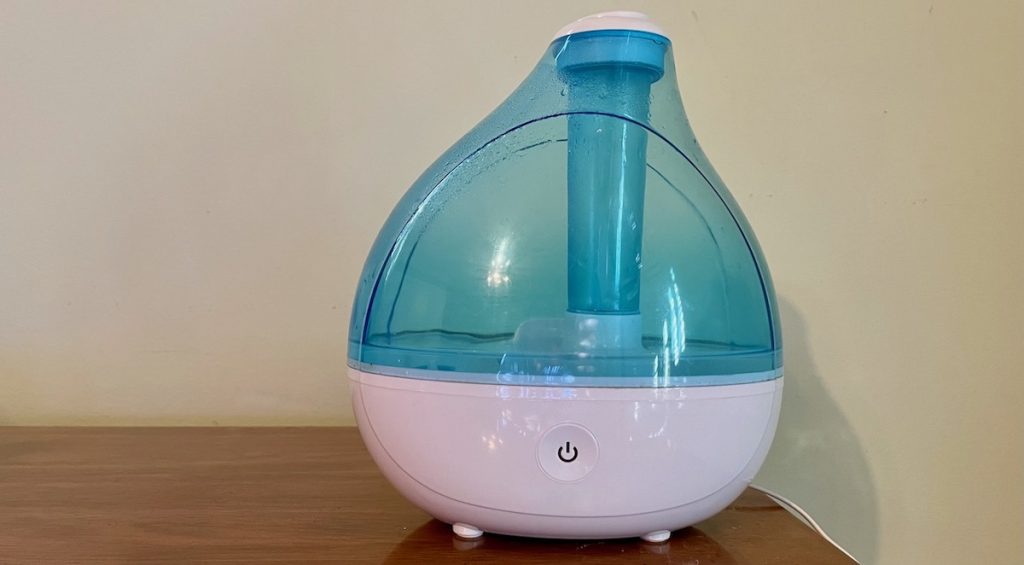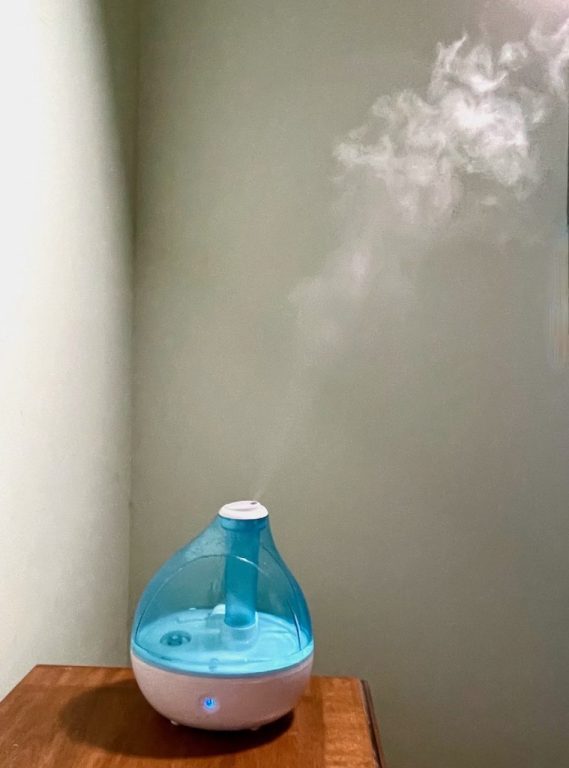
No, Your Ultrasonic Humidifier Doesn’t Hurt Your Dog’s Ears
The mechanism in an ultrasonic humidifier has a frequency much too high for dogs to hear. Ultrasonic humidifiers use frequencies ranging from approximately 1,600,000 Hz to 3,000,000 Hz. Dogs can hear up to 45,000 Hz. The sound produced by this very high-frequency device is profoundly out of hearing range for both dogs and humans.
Although sounds outside our hearing range can in some cases damage humans’ ears and possibly dogs’, I’ve seen this documented only for extremely low-frequency sounds (Kugler et al., 2014), not high.
Humans tend to assign a glamour around the fact the dogs can hear in a higher frequency range than we can. Maybe it’s mysterious because we don’t know what’s going on up there? We feel like anything could be happening since we can’t hear it! Whatever the reason, there is a ton of misinformation online about dogs’ responses to high-frequency noises. I’m tackling this myth about ultrasonic humidifiers first.
This post includes a lot of discussion of sound frequency; if you need a review of the concept, check out my post that includes an explanation. Also, you will see me writing out the numerals for frequencies in this piece rather than using the common scientific shorthand. For instance, I will write 1,600,000 Hz instead of 1.6 MHz. I want the magnitude of the numbers to be clear to all readers.
What Is Ultrasound and Can Dogs Hear It?
Ultrasound is defined as sound higher than 20,000 Hz. That base frequency is the approximate upper limit of human hearing.
But the term “ultrasound” has two common usages, and this causes confusion.
One usage is to refer to frequencies in the range immediately above the limit of human hearing. Sometimes an upper limit of this “lower” ultrasound is given as 25,000 Hz or 40,000 Hz. Dogs can hear in this range. I’ve also seen “low-frequency ultrasound” defined as up to 100,000 Hz.
That’s the first usage, and you can see it’s a little fuzzy.
The other usage of “ultrasound” refers to very high-frequency sound in the millions of Herz. These are the frequencies of ultrasound often used in medicine and industry.
These two usages often result in people worrying that dogs can hear up in the millions of Herz range, but they can’t.
Dogs with normal hearing can definitely hear sounds above 20,000 Hz, as in the first usage. Their hearing range tops out at about 40,000–45,000 Hz (Heffner, 1983). They can’t even come close to hearing sound with frequencies of a million Herz.
For a complete comparison of dogs’ hearing with that of humans, check out my blog post on the topic.
What Frequencies Do Ultrasonic Humidifiers Use?
Ultrasonic humidifiers have a vibrating plate that creates ultrasonic waves ranging from 1,600,000 to 3,000,000 Hz (Al-Jumaily & Meshkinzar, 2017; Yao et al., 2019; Yao, 2016).
The function of ultrasound in humidifiers is to atomize the water in the tank into tiny droplets, creating a mist.
In general, the higher the frequency of the ultrasonic vibration, the smaller the droplets produced.
To reiterate, the ultrasound frequencies used by humidifiers are far too high for dogs to hear. A humidifier using a 1,600,000 Hz mechanism is operating at a frequency 36 times the upper limit of dogs’ hearing.
We are not even talking about the same ballpark.
Can Ultrasound Cause Damage to Dogs’ Ears?
It could, in the lower range of ultrasound I’ve discussed. But such a sound would rarely be encountered, and it wouldn’t be coming from a humidifier.
The important factors in causing ear damage are the sound pressure level (SPL) experienced by the individual and the duration—not the frequency. So higher frequencies are not intrinsically worse for dogs’ ears. A noise in the ultrasound range would need to be very loud to cause damage, just as is the case in other ranges of the sound spectrum.
Ultrasound in the lower range can also be damaging if it is focused by a medical or industrial instrument. For example, ultrasound around 25,000 Hz is finely targeted to break up kidney stones in humans. This is a frequency dogs can hear, but what are the odds of a direct, focused exposure to a dog’s ear?
Neither of these cases apply to humidifiers because of the difference in frequency range, and would rarely be encountered by humans or dogs in day-to-day life.
I haven’t found any literature indicating that ultrasound in the millions of Herz would cause ear damage to dogs or humans. I’ll be looking further to make sure, but my guess is that it’s not something to worry about, for two reasons. First, it would be rare to encounter a loud sound source in that frequency range. That takes some extremely specialized equipment. Second, sound waves at ultra-high frequencies dissipate and attenuate (roughly, they scatter and get quieter) very fast as they travel through air.
In a future post, I will review possible sources of psychological irritation from ultrasound. There are indeed sounds in the lower ultrasound range that your dog might hear and find irritating or scary even though they don’t damage his ears. I’ll discuss ways to detect sounds in this range in your home. I’m not including these topics here because they don’t relate to the ultrasound frequencies humidifiers use.
Consumer Cautions about Ultrasonic Humidifiers
If you read up on the safety of ultrasonic humidifiers, you will find lots of cautions about the fact that they can aerosolize mold, bacteria, and even minerals in water (Environmental Protection Agency, 1991; Yao et al., 2019; Dietrich, Yao, & Gallagher, 2022). These cautions actually made me start cleaning out my humidifier more often and I plan to get distilled water to use instead of tap water.
In the safety instructions, you will not find any cautions about the ultrasounic waves.
Why Did I Even Write about This?
Search the title of this post in Google and you’ll see. There is so much misinformation online about dogs and high frequencies. This post is just a start. Next, I’ll be discussing the erroneous belief that somehow, all sounds with frequencies in the upper half of dogs’ hearing range are intrinsically annoying, painful, or harmful to them.
Copyright 2023 Eileen Anderson
Other Dogs and Sound Posts
• Impulse Sounds and the Startle Reflex: Why Some Dogs Fear the Clicker Sound
• How to Soundproof a Dog Crate
• Review of Pawnix Sound Cancelling Headphones for Dogs: Unlikely to Work as Described
• My webinar on dogs and sound: Sound Decisions
• How to Tone Down That Plastic Collar Click (and Why)
• How I Taught My Dog to Love the Sound of Velcro
• Using Sound Masking to Protect Your Dog from Loud, Scary Sounds
• Are Dogs Ever Irritated by Sights, Sounds, or Smells?
• 6 Ways to Prepare Your Dog for Fireworks
References
Al-Jumaily, A. M., & Meshkinzar, A. (2017). On the development of focused ultrasound liquid atomizers. Advances in Acoustics and Vibration, 2017.
Dietrich, A. M., Yao, W., & Gallagher, D. L. (2022). Exposure at the indoor water–air interface: Fill water constituents and the consequent air emissions from ultrasonic humidifiers: A systematic review. Indoor air, 32(11), e13129.
Environmental Protection Agency. (1991). Indoor Air Facts No. 8: use and care of home humidifiers.
Heffner, H. E. (1983). Hearing in large and small dogs: Absolute thresholds and size of the tympanic membrane. Behavioral Neuroscience, 97(2), 310.
Kugler, K., Wiegrebe, L., Grothe, B., Kössl, M., Gürkov, R., Krause, E., & Drexl, M. (2014). Low-frequency sound affects active micromechanics in the human inner ear. Royal Society Open Science, 1(2), 140166.
Yao, Y. (2016). Research and applications of ultrasound in HVAC field: A review. Renewable and Sustainable Energy Reviews, 58, 52-68.
Yao, W., Gallagher, D. L., Marr, L. C., & Dietrich, A. M. (2019). Emission of iron and aluminum oxide particles from ultrasonic humidifiers and potential for inhalation. Water research, 164, 114899.


